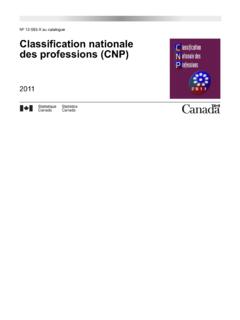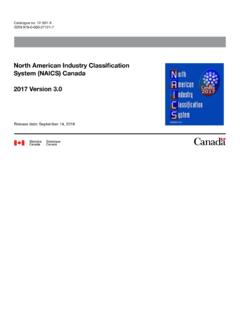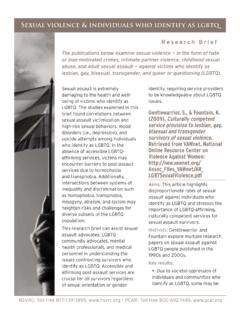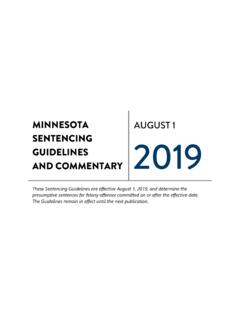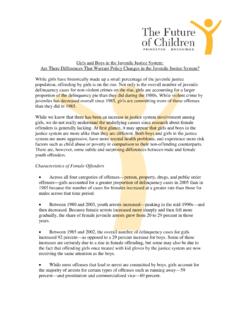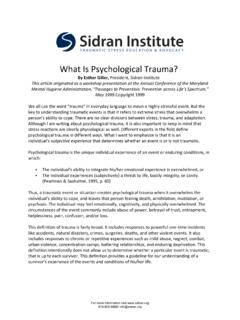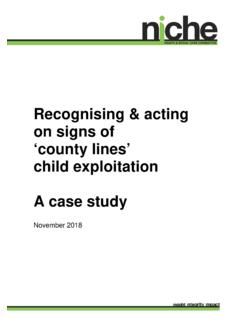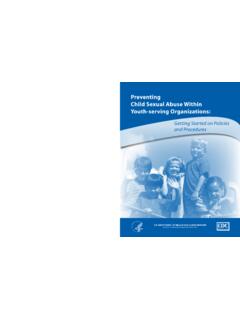Transcription of Family violence in Canada: A statistical profile, 2015
1 JuristatCatalogue no. 85-002-XISSN 1209-6393by Marta Burczycka and Shana ConroyCanadian Centre for Justice StatisticsFamily violence in Canada: A statistical profile, 2015 Release date: February 16, 2017 Standard table symbolsThe following symbols are used in Statistics Canada publications:. not available for any reference period .. not available for a specific reference period .. not applicable 0 true zero or a value rounded to zero 0s value rounded to 0 (zero) where there is a meaningful distinction between true zero and the value that was rounded p preliminary r revised x suppressed to meet the confidentiality requirements of the Statistics Act E use with caution F too unreliable to be published * significantly different from reference category (p < )How to obtain more informationFor information about this product or the wide range of services and data available from Statistics Canada, visit our website, You can also contact us by email at telephone, from Monday to Friday, 8:30 to 4:30 , at the following numbers.
2 statistical Information Service 1-800-263-1136 National telecommunications device for the hearing impaired 1-800-363-7629 Fax line 1-514-283-9350 Depository Services Program Inquiries line 1-800-635-7943 Fax line 1-800-565-7757 Published by authority of the Minister responsible for Statistics Canada Minister of Industry, 2017 All rights reserved. Use of this publication is governed by the Statistics Canada Open Licence HTML version is also publication est aussi disponible en fran of appreciationCanada owes the success of its statistical system to a long-standing partnership between Statistics Canada, the citizens of Canada, its businesses, governments and other institutions. Accurate and timely statistical information could not be produced without their continued co-operation and of service to the publicStatistics Canada is committed to serving its clients in a prompt, reliable and courteous manner.
3 To this end, Statistics Canada has developed standards of service that its employees observe. To obtain a copy of these service standards, please contact Statistics Canada toll-free at 1-800-263-1136. The service standards are also published on under About us > The agency > Providing services to Canadians. Statistics Canada Catalogue no. 85-002-X 3 Juristat Article Family violence in Canada: A statistical profile, 2015 Family violence in Canada: A statistical profile, 2015 Introduction Family violence in Canada: A statistical Profile is an annual report produced by the Canadian Centre for Justice Statistics under the Federal Family violence Initiative. Since 1998, this report has provided the most current data on the nature and extent of Family violence in Canada, as well as analysis of trends over time. The information presented here is used extensively to monitor changes that inform policy makers and the public.
4 The 2015 edition of the report features an in-depth analysis of self-reported childhood maltreatment in Canada, using data from the 2014 General Social Survey on Canadians' Safety (Victimization). This featured section examines the nature and prevalence of self-reported childhood physical and sexual abuse in Canada, as well as the issue of children witnessing violence in the home. The analysis is based on adult Canadians recollections of child abuse they experienced before they turned 15 years of age, and includes incidents that were reported to police as well as those that were not. The featured section also provides analysis of the socio-demographic risk factors linked to child maltreatment and the impacts and consequences it has for victims. As in past years, this year s report also includes sections dedicated to police-reported data on Family violence in general, intimate partner violence specifically, violence against children and youth and violence against seniors.
5 Presented in a fact sheet format accompanied by detailed data tables, these sections provide readers with key findings for 2015 from the Uniform Crime Reporting Survey and Homicide Survey. In this report, Family refers to relationships defined through blood, marriage, common-law partnership, foster care, or adoption; Family violence refers to violent criminal offences where the perpetrator is a Family member of the victim, as defined above. Section 1: Profile of Canadian adults who experienced childhood maltreatment Section 2: Police-reported Family violence in Canada An overview Section 3: Police-reported intimate partner violence Section 4: Police-reported Family violence against children and youth Section 5: Police-reported Family violence against seniors Survey description Statistics Canada Catalogue no. 85-002-X 4 Juristat Article Family violence in Canada: A statistical profile, 2015 Section 1: Profile of Canadian adults who experienced childhood maltreatment by Marta Burczycka Highlights Findings from the 2014 General Social Survey show that one-third of Canadians aged 15 and older (33%) experienced some form of child maltreatment before age 15.
6 Child maltreatment includes physical and/or sexual abuse by someone aged 18 or older, and/or witnessing violence by a parent or guardian against another adult. Childhood physical abuse was reported by 26% of Canadians, while 8% reported sexual abuse. One in ten Canadians (10%) stated that, before age 15, they had witnessed violence by a parent or guardian against another adult in the home. The majority of child witnesses 7 in 10 (70%) also reported having been the victim of childhood physical and/or sexual assault . Those who witnessed parental violence were more likely to have suffered the most severe forms of physical abuse. The majority (65%) of victims of childhood physical and/or sexual abuse reported having been abused between 1 and 6 times, while 20% reported between 7 and 21 instances. One in seven victims (15%) reported having been abused at least 22 times. With respect to the most serious instance of physical abuse that they experienced, the majority of victims indicated that a parent or step-parent was responsible (61%).
7 Childhood sexual abuse, however, was most often perpetrated by someone outside the Family (61%). More than 9 in 10 (93%) victims of childhood physical and/or sexual abuse did not report the abuse to either police or child protection services before they turned 15. In fact, the majority of victims (67%) did not speak to anyone, including friends or Family . Two in every five Aboriginal people (40%) reported having experienced childhood physical and/or sexual abuse, a larger proportion than among non-Aboriginal people (29%). Abuse during childhood was prevalent among Aboriginal women (42%) compared to non-Aboriginal women (27%). While a history of childhood physical and/or sexual abuse was more common among Aboriginal people than non-Aboriginal people overall, this was only the case for those aged 30 and older. Among people aged 15 to 29, equal proportions of Aboriginal and non-Aboriginal people reported childhood physical and/or sexual abuse.
8 Almost half of people aged 15 and older who identified as gay, lesbian and bisexual reported having experienced childhood physical and/or sexual abuse (48%). This compared to 30% of heterosexual people. Those who were physically and/or sexually abused as children were more than twice as likely to have experienced violent victimization as adults during the 12 months preceding the survey (7% versus 3% among non-victims). After controlling for other factors, they were at a higher risk of being the victim of both spousal and non-spousal violence later in life. Adult victims of childhood physical and/or sexual abuse had a higher prevalence of self-reported mental or psychological limitations than non-victims (10% versus 4%), and were more likely to report poor physical health (14% versus 9%). Illegal drug use was twice as common among those who reported having experienced physical and/or sexual abuse as children (10% versus 6% of non-victims).
9 Similarly, binge drinking was reported by those who had been abused as children more often than by those who had not been abused (28% versus 25%). Very little difference was found between people who had experienced physical and/or sexual abuse as children and those who had not when it came to key socioeconomic elements such as education, employment and income. Child maltreatment has been identified by some experts as a global public health concern, associated with numerous negative short and long term outcomes for victims as they move through life (United Nations 2006). The negative outcomes of childhood maltreatment are varied and can include poor school performance, delinquency, poor physical and mental health outcomes as well as experiencing further victimization in adulthood (Afifi et al. 2012; Afifi et al. 2014; Afifi et al. 2016; Perreault 2015). Creating a measure of child maltreatment presents various challenges.
10 Measures based on police-reported data are limited to those incidents that come to the attention of police. Crimes against children may be especially under-reported to police, as children may be unaware of the criminal nature of the acts that they are experiencing, be fearful of the consequences of reporting them to the police, and lack the social supports to make reporting to police seem viable (Finkelhor 2008; Cotter and Beaupr 2014). Conversely, other data sources may be constrained by ethical considerations, which limit the extent to which researchers can gather information on child abuse directly from the children who experience it. Statistics Canada Catalogue no. 85-002-X 5 Juristat Article Family violence in Canada: A statistical profile, 2015 Retrospective reporting of child abuse that is, adults reporting on their experiences of abuse during their childhood may address such limitations.

